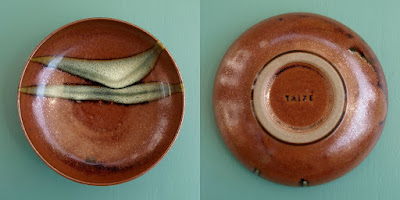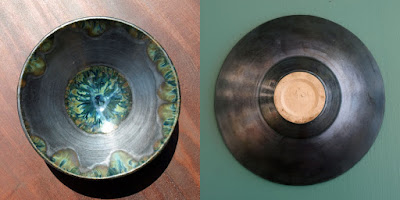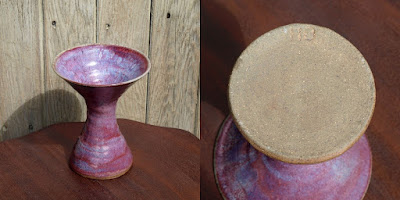FREE SHIPPING ON ALL ITEMS AT FAB FINGS
Vintage Studio Pottery Identification
Here is a catalogue of vintage and more recent studio pottery photos and, where possible, identification and maker's marks. Examples added as and when they are sourced for sale at Fab Fings. If you can add any missing information to any of the pieces then please do leave a comment.
The studio pottery piece above is a vintage green glazed handmade earthenware Welsh lidded pot by Llangollen.
Go HERE to see if the pot is still for sale.

The piece of studio pottery above is a stoneware bowl by Taize of Burgandy of France, set up by Daniel de Montmollin and run by monks. Beautiful piece with interesting glazed. 17cm diameter and 5cm tall.
Go HERE to see if this bowl is still for sale.

The studio pottery piece above is a Rachel Padley signed bowl. Graphite grey glaze and sea green drip glaze. Beautiful and rare bowl by this acclaimed English artist and in mint condition. 17.5cm diameter and 5.5cm tall. This piece is number '01' so it was the first of its kind.
This lovely pink stoneware studio pottery vase is signed 'H.O.' but, alas, the maker has not been identified.

The studio pottery piece above is a Rachel Padley signed bowl. Graphite grey glaze and sea green drip glaze. Beautiful and rare bowl by this acclaimed English artist and in mint condition. 17.5cm diameter and 5.5cm tall. This piece is number '01' so it was the first of its kind.

This lovely pink stoneware studio pottery vase is signed 'H.O.' but, alas, the maker has not been identified.
Click HERE to see if this vase is still for sale.

The large stoneware plate above was made by Diana Worthy of Crich Pottery.

The beautiful globe mug above was made by John Vasey of St Agnes Pottery in Cornwall.

The studio pottery stoneware nuka hakeme bowl above is by Trevor Corser Leach Pottery.
See the current stock at Fab Fings of VINTAGE STUDIO POTTERY.
THE HISTORY OF BRITISH STUDIO POTTERY
British studio pottery is a type of pottery that is made by individual artists, rather than in a factory. It is typically made in small batches, and it often features unique designs and techniques.
British studio pottery began to gain popularity in the early 20th century, when a number of artists began to experiment with new ways of making pottery. These artists were inspired by the Arts and Crafts movement, which promoted the use of simple, functional designs.
One of the most famous British studio potters was Bernard Leach. Leach was born in Devon in 1887, and he began his career as a painter. However, he was soon drawn to pottery, and he traveled to Japan in 1910 to study traditional Japanese pottery methods.
After returning to England, Leach founded the Leach Pottery in Cornwall. The Leach Pottery is still in operation today, and it is one of the most well-known British studio potteries.
Leach's work is characterized by its simple, functional designs and its use of natural materials. He was also a pioneer of the use of glazes, and he experimented with a variety of different glazes to achieve different effects.
Another famous British studio potter was Lucie Rie. Rie was born in Vienna in 1888, and she began her career as a painter. However, she was soon drawn to pottery, and she studied in Germany and Italy before settling in London in 1931.
Rie's work is characterized by its use of simple, functional designs and its use of natural materials. She was also a pioneer of the use of stoneware, and she experimented with a variety of different stonewares to achieve different effects.
British studio pottery has continued to grow in popularity in recent years. There are now many different British studio potters working, and their work is exhibited in galleries and museums around the world.
British studio pottery is a unique and beautiful art form. It is a testament to the creativity and ingenuity of British potters over the centuries.
STUDIO POTTERY TECHNIQUES
There are many different studio pottery techniques, but some of the most common include:
- Slip casting: This technique involves pouring a liquid clay (slip) into a mold. The slip then hardens in the mold, forming the desired shape.
- Handbuilding: This technique involves building pottery pieces by hand. The clay is rolled out into sheets, slabs, or coils, and then it is shaped and joined together.
- Wheel throwing: This technique involves throwing pottery on a wheel. The clay is thrown into a shape on the wheel, and then it is shaped and refined.
- Glazing: This technique involves applying a glaze to a pottery piece. The glaze is a liquid glass that covers the surface of the pottery and protects it.
- Firing: This technique involves heating a pottery piece to a high temperature. The heat causes the clay to harden and the glaze to fuse to the surface.
Each of these techniques has its own advantages and disadvantages. Slip casting is a quick and easy way to create intricate shapes, but it is not as versatile as handbuilding or wheel throwing. Handbuilding is a more versatile technique, but it takes more time and effort to create complex shapes. Wheel throwing is a very versatile technique, but it requires a lot of skill and practice to create beautiful pottery. Glazing is a way to add color and protect pottery pieces, but it can be difficult to get the desired effect. Firing is a necessary step in the creation of pottery, but it can be dangerous and expensive.
BUYING VINTAGE STUDIO POTTERY
If you are interested in collecting vintage studio pottery, there are a few things you should keep in mind. First, it is important to do your research and learn about the different artists and styles of pottery. Second, it is important to inspect the pottery carefully before you buy it. Make sure that the pottery is in good condition and that there are no cracks or chips. Third, it is important to be patient. It can take time to find the perfect piece of vintage studio pottery.
If you are lucky enough to find a piece of vintage studio pottery that you love, cherish it. Vintage studio pottery is a beautiful and unique art form that can add a touch of personality to your home.
Display prices in:GBP


